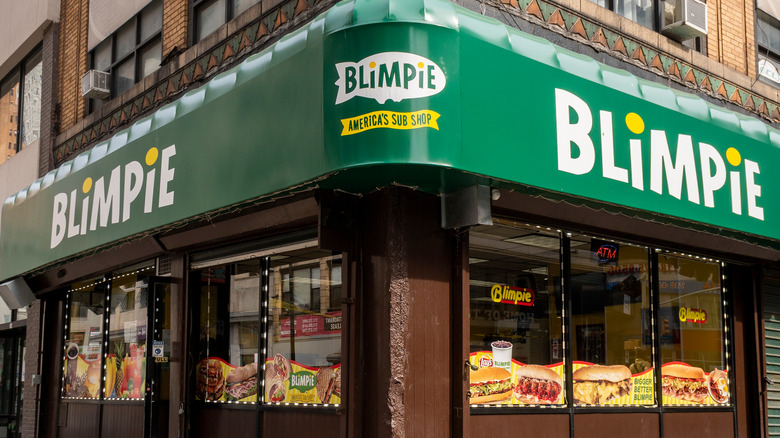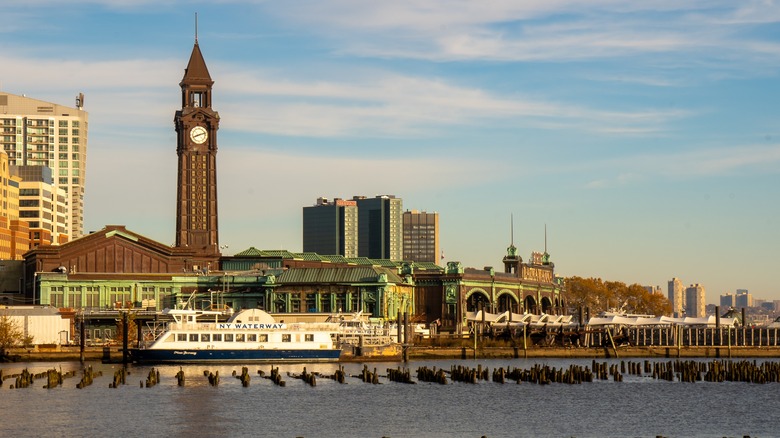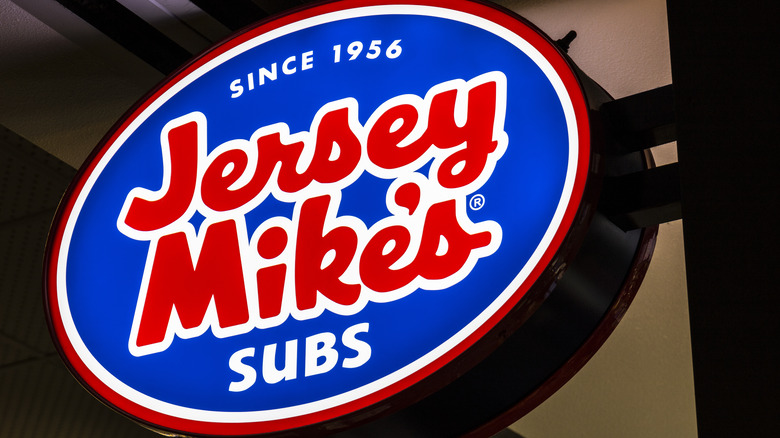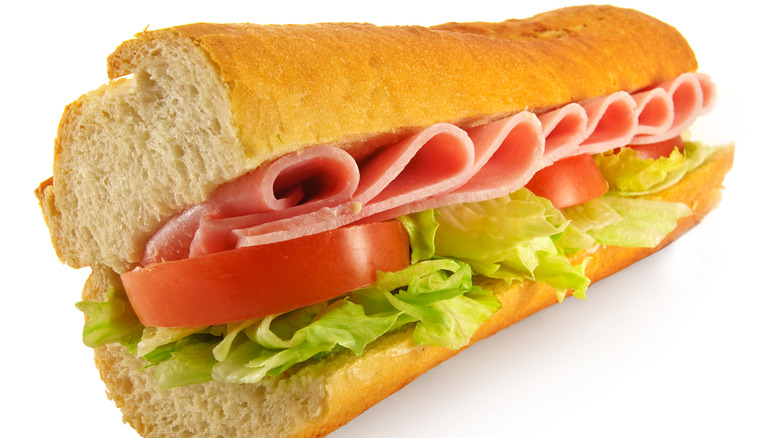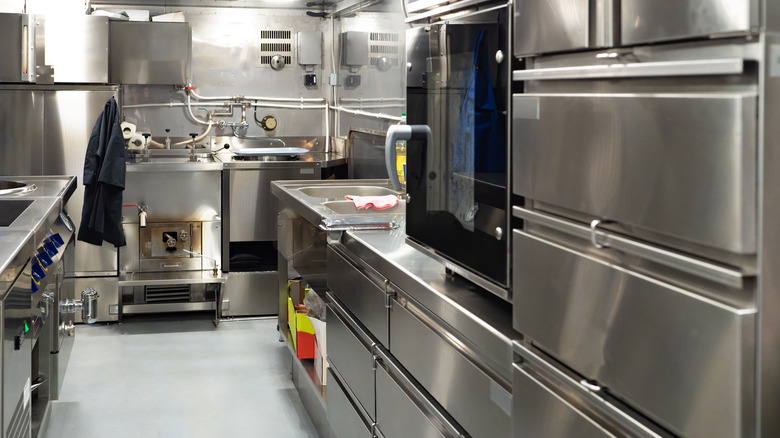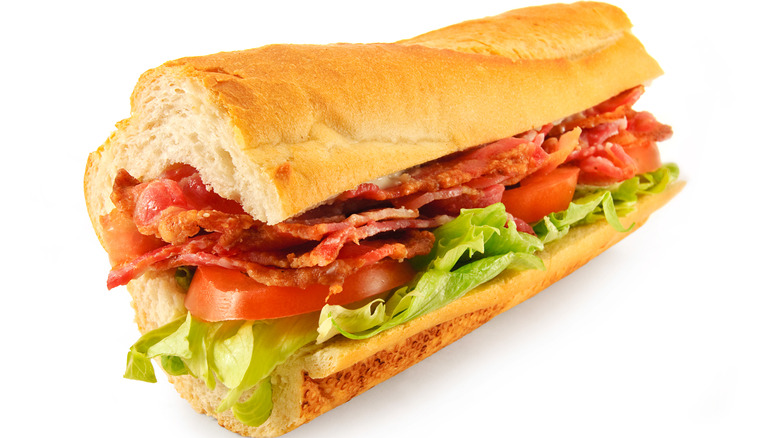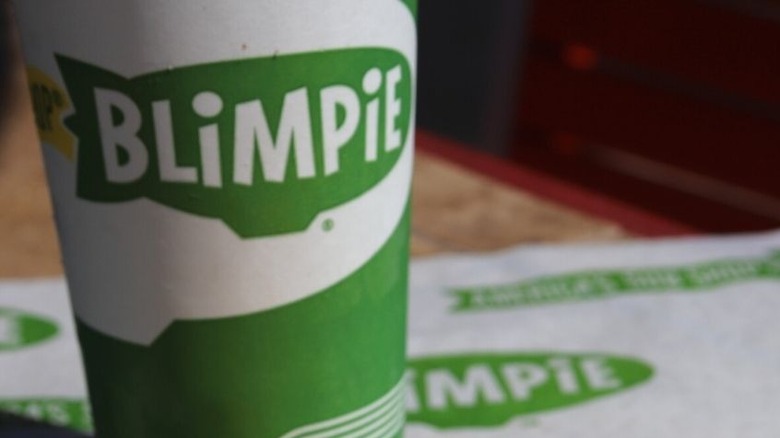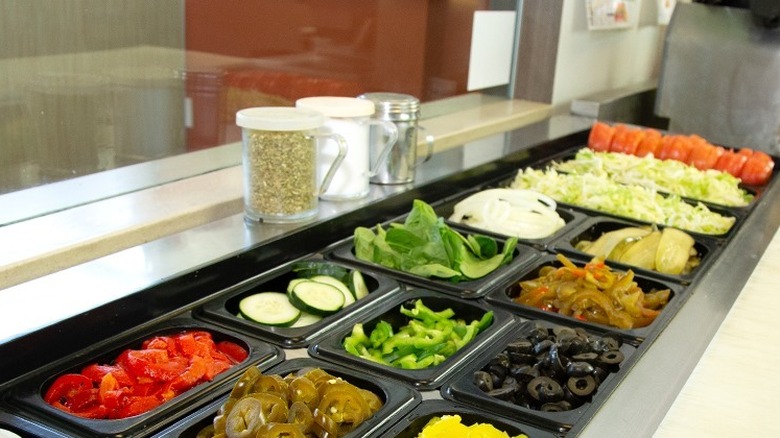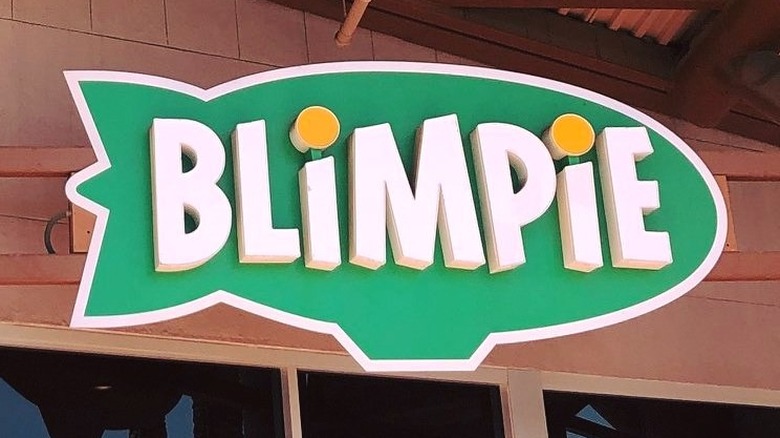The Untold Truth Of Blimpie
The only sub shop denoted by a zeppelin, Blimpie provides a hoagie experience that's unlike most, and it's becoming increasingly harder to find. Starting off in 1964 and with an oscillating history of expansion and contraction, Blimpie is an eatery that's behaved like its blimp logo — it soared to great heights over several rises, and deflated into obscurity during its downturns.
Although competitors are crowding it out of the market, Blimpie is still hawking hoagies to nearly every corner of America (via QSR). Its menu is robust and continues to expand, becoming known for more than subs as it dabbles in the art of the panini and continues catering to large parties.
Throughout its seesaw history, Blimpie tells an exciting story of how it's survived many dark nights of the soul and has emerged a resilient company. Nearly 60 years on, Blimpie continues to fight the downdrafts in an effort to remain true to its tagline as "America's Sub Shop."
The first Blimpie was launched in Hoboken, N.J.
Blimpie began its journey on the Jersey side of the Hudson River when 3 high school pals teamed up after graduation to develop it with $2,500 in funding, They opened the first Blimpie at the corner of Seventh and Washington Streets in Hoboken, N.J., according to NJ.com.
The year was 1964, and Blimpie didn't want to sound like just another submarine sandwich company — a factor that factored into its name. Scouring a dictionary, Blimpie's young brain trust was quickly drawn to the word '"blimp" and the accompanying picture that they felt resembled the bread of a submarine sandwich (per QSR).
The ship-to-sub comparison was apt enough for founders Tony Conza, Peter DeCarlo, and Angelo Baldassare, who approved a name that would see the company long past its first location. That being said, Blimpie's first sandwich shop no longer exists (via HMag).
Blimpie was inspired by the sub shop that would become Jersey Mike's
Blimpie's ideological foundation was first laid out during a party conversation between founders Tony Conza, Peter DeCarlo, and Angelo Baldassare in Jersey City, N.J. According to the New York Times, the atmosphere and accompanying drinks catalyzed a brainstorm of business ideas. Unsure of what kind of venture to start, the future Blimpie founders tossed around concepts until they eventually settled on the idea of a sandwich shop.
Blimpie's belief that this concept could work was backed by the success of Mike's Submarines in Point Pleasant, N.J., a place that was typically bursting with patronage. Intrigued by its popularity, Blimpie's founders performed some culinary espionage by eating some of Mike's Subs. Impressed by what they ate, they opened their own sandwich shop in a similar vein. Mimicking their mentor proved a sage choice, as both sandwich chains still exist today. There is one exception, though — Mike's Submarines is now known as Jersey Mike's.
To ward off early struggles, two of Blimpie's owners sold all of their franchises
Long before "move fast and break things" became a popular startup motto, Blimpie was stirring up dust and drywall in the 1960s. Aggressively gunning for expansion, the founders of Blimpie exploded their base readily. By 1967, they had successfully expanded into Manhattan, with 10 Blimpies already churning out hoagie-style subs (via Blimpie).
Four of these franchises were owned by founders Tony Conza and Peter DeCarlo, and although it may not sound like much in our age of easy venture capital, running 4 Blimpies back then proved more than Conza and DeCarlo could handle.
Unable to keep lightning in the bottle without a formal business education, Conza and DeCarlo were flying by the seat of their pants. Per the New York Times, Conza and DeCarlo "admitted they weren't skilled businessmen." As it turned out, they were "incautious about the costs of goods and employee salaries."
Conza and DeCarlo would bend but would not fold, selling all 4 Blimpies they personally owned. They shifted their focus on building back Blimpie's bottom line through franchising.
In 1976, Blimpie fractured into two companies
It's tough to keep even the best teams together, and the Blimpie crew was no exception. Citing a difference in opinion, as DeCarlo wanted to keep Blimpie East Coast and Conza wanted to expand southward, the original founders decided to reform Blimpie into 2 distinct companies under the same trademark (via Reference for Business).
It was decided DeCarlo would run Blimpie Metropolitan and retain control of the majority of Blimpie's New York, New Jersey, and East Coast locations. Conza would head the original company, but renamed it International Blimpie Corporation while crafting a new imprint. Conza relished the opportunity and quickly franchised Blimpies "wherever there was interest," according to the New York Times. Conza would eventually admit the error of his ways, and over the years, many of those locations damaged the brand before closing down. They allegedly drove customers up the wall with filthy bathrooms and discordant employees.
Blimpie went public in 1983
In the blur of Blimpie's forced growth throughout the 70s and 80s, they also sought public investment. Blimpie's rise was rapid, but stores were closing rapidly as well (via Reference for Business). It's clear the underwriter held reservations, as Blimpie's initial public offering debuted at 90 cents per share — an unpromising number, even when adjusted for inflation. It served as a flashing indicator that the 80s would bring turbulent times for this blimp-inspired brand.
Blimpie's aggressive expansion also resulted in marks against sanitation. Founder Tony Conza's loose approach to franchising led to undisciplined franchisees and resulted in a massive identity crisis for the Blimpie brand. According to the New York Times, Blimpie had such "renegade owners" who flouted their business formula that some bad actors even sold Chinese food and pizza. However, there was a silver lining — these maverick moves were also a cry for help, begging Blimpie to expand its menu. It became an idea it pursued in the following decade.
Blimpie moved away from subs in the 1980s
If you've ever wondered why Subway is so enormous, a big part of that may be Blimpie's decision to pump the brakes on its best product in the 1980s: the sub sandwich.
As Subway made moves in the submarine sandwich sector, Blimpie pivoted toward a sit-down restaurant idea that became the Border Cafe (via the New York Times). It was a short-lived endeavor that hemorrhaged funds shortly after striking ground in Manhattan. Although Border Cafe's initial numbers were promising, not even former New York Yankee great Dave Winfield could save them as a partial owner (via Reference for Business). However, that was the small problem. The big problem? Blimpie gave Subway an inch and it took a mile. It padded a sandwich-selling lead that only grew wider and would never again be threatened by Blimpie.
Today Subway boasts over 40,000 locations (via Statista), while Blimpie taxies at the back of the pack with approximately 156 locations as of this writing (via Blimpie).
Blimpie's CEO once devised a list of "101 Small Improvements"
Although co-founder Tony Conza made several mistakes while shepherding Blimpie, he shouldered through the rough business terrain by steadily seeking improvement. He said goodbye to his failed restaurant, the Border Cafe, and focused his acumen on the singular target of improving sales at Blimpie (via the New York Times).
Devising a list of "101 Small Improvements" and doling out the guide to his top-level managers, Conza allocated his clout to restoring a line of communication between Blimpie corporate and its franchisees that had long been neglected (per Reference for Business).
In the same vein as "101 Small Improvements," Blimpie also engaged in cleaning up its 140 shops across the Empire State, while Conza jet-setted across the country, keeping a close eye on his franchises. On top of that, Conza also formed a council, aimed to keep him current on Blimpie's biggest problems.
Blimpie's CEO launched a periodical titled "No Baloney News"
The 1980s were known for synthesized music, sweaters with shoulder pads, and tough times at Blimpie. Franchisees were reportedly disgruntled and gave Blimpie a bad reputation through their expressions of discontent (via the New York Times).
It's tough not to imagine the fallout from the powder keg when Blimpie's plans for expansion backfired in the 1980s (via Reference for Business). However, the CEO of International Blimpie Incorporated, Tony Conza, remained determined and would stop at nothing to keep the business afloat. Ramping up his involvement by taking myriad measures into his own hands, Conza even authored a newsletter in an effort to help solve Blimpie's problems holistically.
Titled "No Baloney News," Conza's bulletin would finally offer top-down guidance for Blimpie franchisees. It became a resource that was sorely needed as sandwich shops sprawled into reckless territory. Better yet, "No Baloney News" was accompanied by a hotline, if franchisees ever needed a tip or had to relay a frustration from the bottom up.
In 1989, Blimpie introduced a reduced calorie menu
Back in the 1980s when fat was declared the enemy of the people, Blimpie took full advantage of the anti-lipid movement with a refreshed menu dubbed "Blimpie Lite."
According to Reference for Business, the low-calorie menu carried tuna, crab, chicken, and turkey salads, and those reduced-fat staples were offered on a pita. These seemingly healthier options proved successful and Blimpie's dietary experiments turned greener. A year later, it rolled out gourmet salads under the sub-brand, Blimpie Fresherie. This move led to increased revenue, as Blimipie ascended toward another peak on its company sales graph. Exiting out of the 1980s better than it entered, Blimpie's 180-degree turn in profit would once again trigger expansion, and it would lead to another precipitous decline. This repeatable pattern wouldn't reveal itself to Blimpie until the late 1990s, as the economy was a red hot bubble for the company.
Blimpie doubled its advertising budget in the 1990s
CEO Tony Conza's hunger for improvement was finally sated in the decade of "Seinfeld" when Blimpie's balance sheet soared into revival. Per Reference for Business, 1990 marked a new dawn for Blimpie, as it was reaching revenue of $120 million per year. In 1992, Blimpie rolled into the stock market again, this time on the NASDAQ exchange. With success courting expansion, Blimpie ballooned to over 500 locations and loosened the purse on its advertising budget, doubling its allotted funds to a sum of $2 million.
As its budget increased, Blimpie's rate of franchise failure declined by one-third throughout the early 90s. By 1993, Blimpie would be available at 670 locations, and in 1994, its 800th location would open up in the Upper Peninsula of Michigan in the small town of Iron City. It proved that Blimpie was back in a big way, for the time being.
Blimpie found quick success franchising at convenience store locations
As the economy heated up in the 1990s, so did Blimpie. An odd catalyst to Blimpie's born-again boom times was its decision to franchise its sandwich shop to convenience store locations. According to Reference for Business, this was a win-win for both Blimpie and just about any convenience store, as convenience store owners were reeling from plummeting cigarette sales. Smoking was a vice that was facing increased scrutiny by the U.S. Surgeon General and legislators alike. Smoking was banned at most indoor locations during the 1990s, and tobacco companies were forced to shovel out hundreds of millions of dollars for anti-smoking campaigns.
Blimpie gladly filled the nascent void, partnering up with Texaco Food Marts in Mississippi and even the food court at the University of Texas. It appeared in nontraditional locations with either a kitchenless restaurant, or a kiosk that could fit in any space offering 100 square feet.
Since the late 1990s, Blimpie has struggled and changed ownership multiple times
Blimpie's hot streak of 90s success would fade in the new millennium, and the hoagie emporium would crash hard. According to USA Today, Blimpie plummeted from 1,853 viable locations and revenue of $300 million in 2001 to just 739 locations and $115 million in revenue by 2011.
In the same decade that Blimpie suffered a beatdown, it also found a prime benefactor. Kahala Brands would snag Blimpie in 2006 before rolling up under the conglomerate of MTY Food Group (via The Globe and Mail). So far, MTY Food Group has kept Kahala intact and Blimpie beneath its banner. According to its website, Kahala Brands run deep with Blimpie sitting shotgun, placing the sub shop in league with other tasty destinations such as Pinkberry, Baja Fresh, and Cold Stone Creamery. These are just a few of the companies on its current roster of 29 restaurant chains at the time of this writing.
